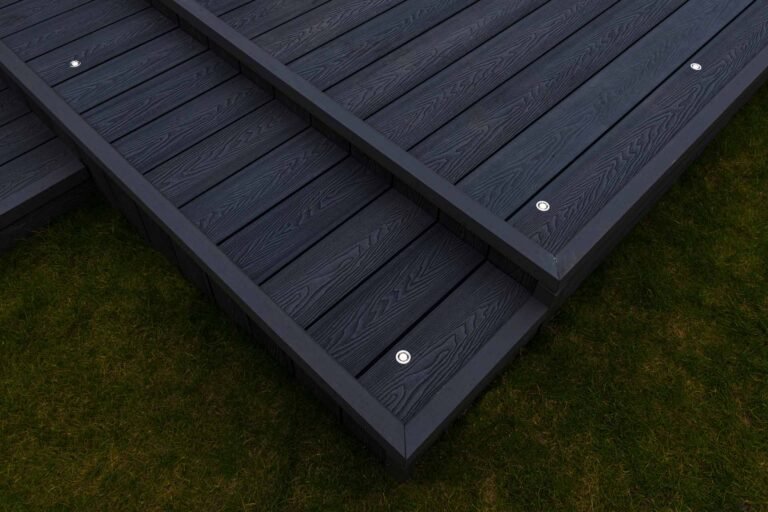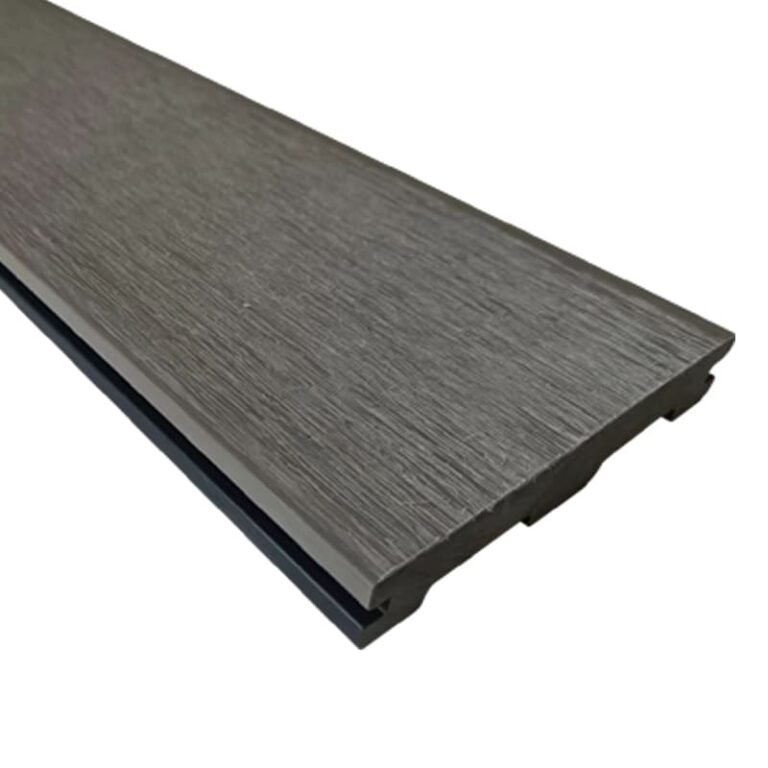Is your composite deck looking dull and dirty? You worry harsh cleaning might cause damage, but leaving it grimy isn't an option. Following the right steps restores its look safely.
To clean a dirty composite deck, start by sweeping away debris. Then, use a soft-bristle brush with warm, soapy water. For stubborn stains like mold or grease, use a cleaner specifically approved for composite materials. Always rinse thoroughly with clean water to prevent any soap residue buildup.
Over my 12 years in this industry, I've seen this question come up countless times from partners all over the world. A beautiful deck is a great selling point, but only if it's maintained correctly. Many well-meaning owners accidentally damage their investment by using the wrong products or techniques. The good news is that keeping a composite deck looking new is simple when you know what to do and what to avoid. Let's look at the specific questions I get most often, so you can advise your own customers with confidence and protect their decking for years to come.
What should you not use on a composite deck?
You want to clean your deck fast, so you grab a strong household cleaner. But using the wrong product can strip the color, scratch the surface, or even void the warranty.
Never use chlorine bleach, metal brushes, or abrasive scouring powders on composite decking. These products are too aggressive and can cause permanent scratches and discoloration. You should also avoid using a pressure washer on a high setting, as it can etch the surface and damage the material.
I can't stress this enough: composite decking is tough, but it's not indestructible. The biggest mistake I see people make is treating it like concrete or stone. Chlorine bleach is a common culprit. It can react with the wood and plastic components in the decking, breaking them down and causing the color to fade unevenly. Abrasive cleaners or scouring pads, even the ones you use in your kitchen, create tiny scratches on the deck's surface. At first, you might not notice them, but these scratches trap dirt and make the deck harder to clean in the future. They also dull the finish. The worst offender is a metal or wire brush. It will absolutely gouge the material, leaving behind deep, permanent scratches that are impossible to fix. I remember a client who tried to scrub a small rust stain with a wire brush and ended up with a much more noticeable problem.
Safe vs. Unsafe Deck Cleaning Tools
| Tool | Why It's Safe/Unsafe | My Recommendation |
|---|---|---|
| Metal Brush | Unsafe. Causes deep, permanent scratches and gouges. | Never use this. It will ruin the deck surface. |
| Pressure Washer (High PSI) | Unsafe. Can etch the surface, strip color, and void warranties. | Avoid high pressure. If you must use one, keep it below 1,500 PSI. |
| Abrasive Powders | Unsafe. Scratch and dull the protective outer layer. | Stick to simple, non-abrasive soap and water. |
| Soft-Bristle Brush | Safe. Cleans effectively without scratching the surface. | This is the best tool for routine cleaning. |
| Garden Hose | Safe. Provides enough pressure to rinse away soap and dirt. | Perfect for a final rinse after scrubbing. |
Does vinegar damage composite decking?
You've heard vinegar is a great natural cleaner. But you hesitate, wondering if its acidity could harm your composite deck. Using the wrong "natural" solution can still cause problems.
Yes, vinegar can damage composite decking. Its acidic nature can dull the finish, cause slight discoloration, and potentially harm the protective cap on some boards. It is best to avoid using straight or strong vinegar solutions. A very diluted mixture might be okay, but safer options exist.
Many people like using vinegar because it’s cheap and they see it as a "green" cleaning solution. I completely understand that logic. However, when it comes to composite decking, you have to be careful. The acetic acid in vinegar[^1] is strong enough to interact with the deck's components. Over time, it can dull the surface, making it look chalky or faded. This is especially true for darker-colored decks. I've also seen cases where it's left faint streaks behind. While a single, highly diluted application might not cause immediate ruin, repeated use will degrade the material's appearance and protective qualities. Why take the risk when a simple solution of mild dish soap and water[^2] works perfectly fine and is completely safe for the material? If you are dealing with mold or mildew, there are specific composite deck cleaners that contain ingredients to kill the spores without harming the deck's surface. These are a much better choice than experimenting with household acids like vinegar.
Acids and Chemicals to Avoid
| Substance | Potential Damage | What to Use Instead |
|---|---|---|
| Vinegar | Dulls finish, can cause discoloration, may weaken protective cap. | Mild dish soap and water. |
| Chlorine Bleach | Fades color, makes material brittle, damages wood fibers. | Oxygen-based bleach cleaners[^3] (if manufacturer-approved). |
| Ammonia | Can be too harsh, may damage the deck's protective layer. | Specific composite deck cleaners. |
| Acetone/Solvents | Can dissolve the plastic components, causing severe damage. | For tough stains like paint, consult the manufacturer first. |
How to clean old composite decking?
Your older composite deck has seen better days. It looks tired and has built-up grime, and you're not sure if a simple wash is enough to bring it back to life.
To clean old composite decking, perform a deep clean using a designated composite deck cleaner that targets mold, mildew, and tough stains. Use a soft-bristle brush to scrub the entire surface thoroughly. For deep-set stains or fading, a commercial-grade deck brightener made for composites can help restore its appearance.
Older decks need a bit more attention, but they can often be restored beautifully. Over the years, dirt and organic matter can get embedded in the grain, and mold or mildew might have taken hold in shaded, damp areas. Start the cleaning process just like you would with a new deck: with a thorough sweep. Then, instead of just soap and water, I recommend choosing a good quality composite deck cleaner. These products are formulated to tackle the specific issues older decks face, like mildew and algae, without being too harsh. Make sure you follow the manufacturer's instructions carefully. You typically apply the cleaner, let it sit for a few minutes to break down the grime, and then scrub with a soft brush. Pay extra attention to the areas between the boards where debris collects. After scrubbing, a complete rinse with a garden hose is critical. Any leftover cleaner can leave a film that attracts more dirt. This process often makes a huge difference, revealing the deck's original color and texture.
Can I use sugar soap on composite decking?
You have sugar soap on hand and know it's a great all-purpose cleaner. You wonder if it's safe for your deck, but you don't want to risk leaving a sticky residue.
Yes, you can generally use sugar soap on composite decking, but it must be diluted correctly and rinsed off completely. If not rinsed away thoroughly, its residue can leave a film on the surface that attracts dirt and dust, making the deck get dirty again faster.
Sugar soap is a product we get asked about a lot, especially by our partners in the UK and Australia. It is a reliable and effective degreaser, and for the most part, it's safe for composite decking if you use it correctly. The key is in the dilution and, more importantly, the rinse. Sugar soap is designed to be powerful, but that means it can leave behind a slightly sticky film if you don't wash it all off. This residue is a magnet for dust, pollen, and dirt, which means your clean deck won't stay clean for long. My advice is this: if you choose to use sugar soap, mix it with water according to the instructions on the package for light cleaning. After you've scrubbed the deck, you need to rinse it with conviction. Go over the entire surface with a garden hose until you are absolutely sure all the soap is gone. To be honest, I still believe that a simple, pH-neutral dish soap is the safer, more foolproof option. It cleans effectively without the risk of leaving a tacky residue behind.
Conclusion
Cleaning your composite deck is straightforward. Use gentle soaps, a soft brush, and always rinse well. Avoid harsh chemicals and high-pressure washers to ensure your deck looks great for years.
[^1]: Learn why vinegar's acidity can dull finishes and cause discoloration, making it a risky choice for deck cleaning.
[^2]: Discover why this simple, pH-neutral solution is recommended for safe, effective cleaning without damaging your deck.
[^3]: Find out when and how to use oxygen-based bleach cleaners for tough stains without harming your composite deck.









